InterActive Module: Advanced Operations Management Report - Tesco PLC
VerifiedAdded on 2022/09/02
|16
|5275
|18
Report
AI Summary
This report provides a comprehensive analysis of Tesco PLC's operations management, focusing on material management, lean and agile techniques, and supply chain strategies. The report explores Tesco's approach to material handling, including the evolution from direct store delivery to centralized and composite approaches, and the importance of vertical collaboration and supply chain techniques. It also delves into Tesco's adoption of lean and agile methodologies, highlighting their benefits in terms of cost reduction, improved quality, and customer satisfaction. Furthermore, the report examines the relationship between material management, logistics, and reverse logistics within Tesco's operations, emphasizing their interdependence and impact on efficiency. The impact of outsourcing and the application of information technology within Tesco's supply chain are also discussed, providing a holistic view of the company's operational strategies and their contribution to its competitive advantage in the retail market.
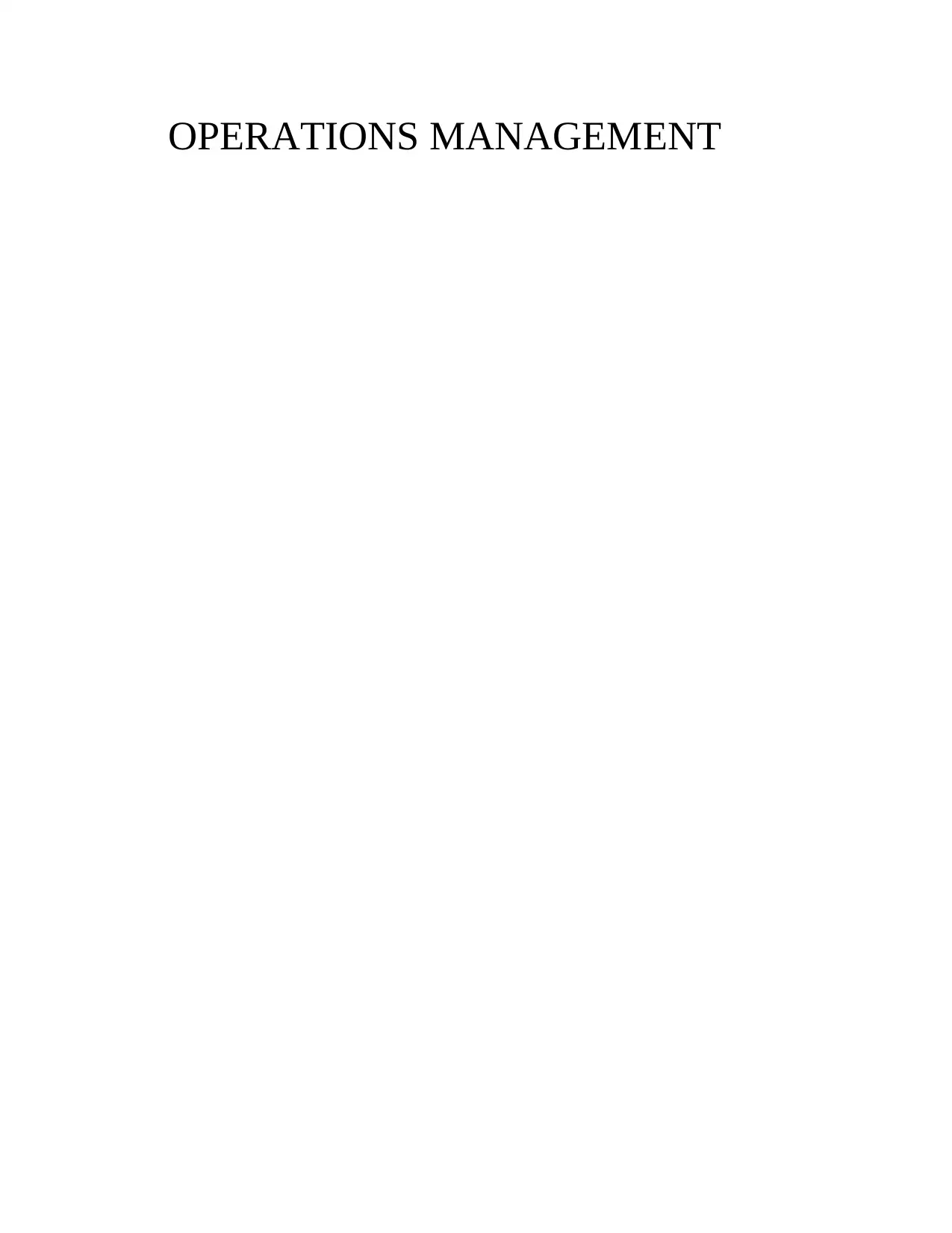
OPERATIONS MANAGEMENT
Paraphrase This Document
Need a fresh take? Get an instant paraphrase of this document with our AI Paraphraser
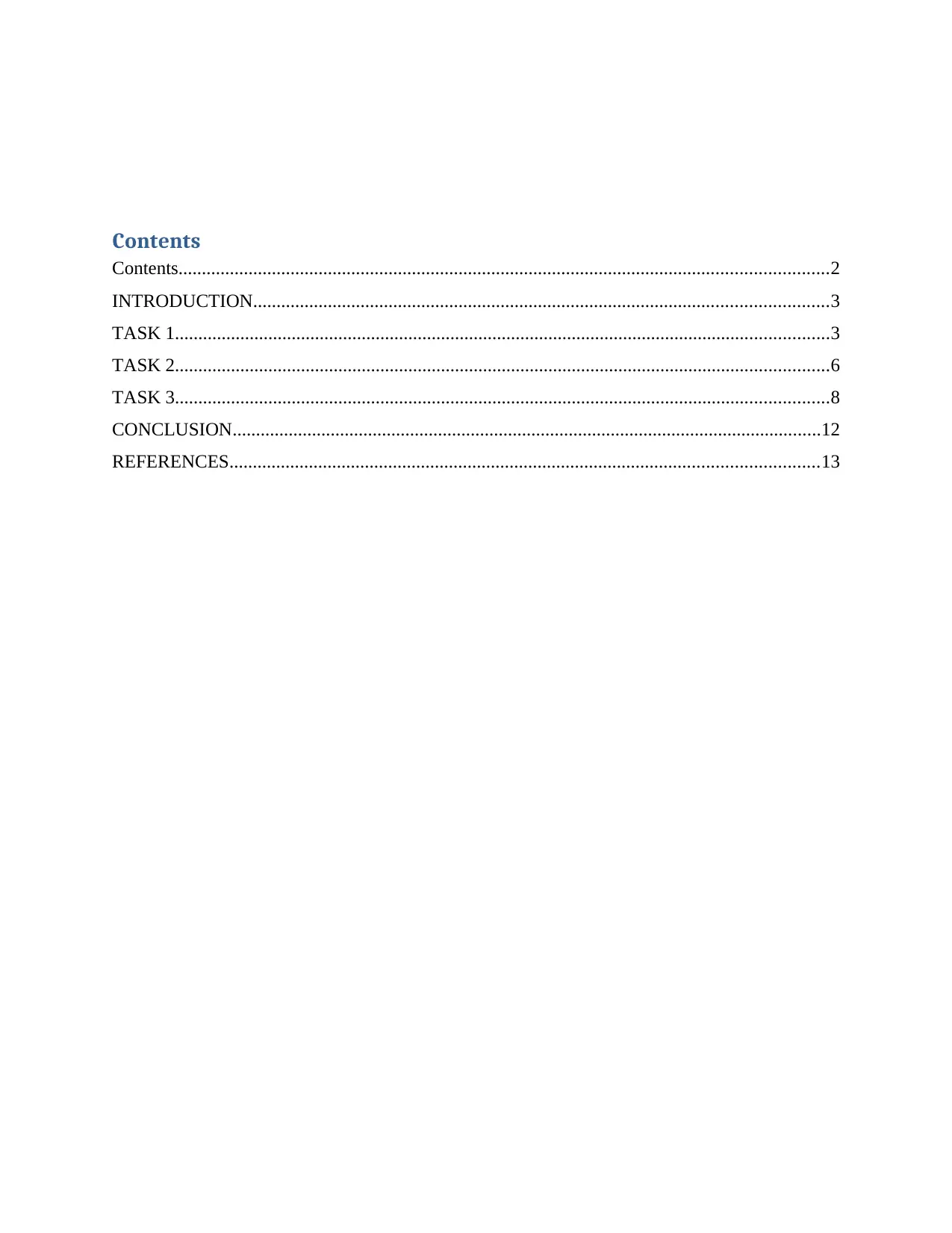
Contents
Contents...........................................................................................................................................2
INTRODUCTION...........................................................................................................................3
TASK 1............................................................................................................................................3
TASK 2............................................................................................................................................6
TASK 3............................................................................................................................................8
CONCLUSION..............................................................................................................................12
REFERENCES..............................................................................................................................13
Contents...........................................................................................................................................2
INTRODUCTION...........................................................................................................................3
TASK 1............................................................................................................................................3
TASK 2............................................................................................................................................6
TASK 3............................................................................................................................................8
CONCLUSION..............................................................................................................................12
REFERENCES..............................................................................................................................13

INTRODUCTION
Material management refers to a process of managing and handling raw materials and final
products produced by company more efficiently and effectively. Or in other words, it is a process
of planning, directing, controlling and monitoring of all the activities which is related to product
so that optimum utilisation of resources would be attain by an organisation (Heizer, Render and
Munson, 2017). For this report, Tesco PLC is taken for consideration which is one of the largest
retail chains in world as well as in United Kingdom. Company has more than 7000 shops
worldwide and has revenue of 63.911 Euro million in 2019 and employees more than 450,000
people worldwide (Reid and Sanders, 2019). Material management is essential and mandatory
for company like Tesco as they have diversified product like books, cloths, electronic
accessories, toys etc which requires management and alignment of products with company’s
vision and goals. Wa ys to adopt lean and agile technique and how it assist company to gain
competitive edge over others is explained. Relationship between MM, logistics and reverse
logistics is also determined by taking functional example of company. Impact of outsourcing and
how it affects organisation performance in the market is also explained. Application of
information technology and how it assist supply chains of company is also determined and
explained in the latter part of the report.
TASK 1
As mentioned above, Material management is a step by step and continuous process of handling
goods or raw materials within business operations so that it would be available at the right time,
to the right place, right person. Primary objective of MM is to reduce wastage in the whole
production process which will turn into profit for company thus better performance in the
market. Due to large number of products and services offered by Tesco, it becomes hard and
complex for them to manage simultaneously. For instance, Tesco sell clothing for Men, Women,
and Kids etc which means more than one supplier is requires for purchasing raw material. Same
concept goes with every product sell by the company. That means, company needs to manage
more than 500 approximately supplier on a daily basis and on every second hence requires
advanced and latest technology to manage it effectively (Hitt, Xu and Carnes, 2016).
Company has approached and implemented various techniques for material handling and
changes according to external and internal needs. In the starting or 1970’s Tesco used to use
Material management refers to a process of managing and handling raw materials and final
products produced by company more efficiently and effectively. Or in other words, it is a process
of planning, directing, controlling and monitoring of all the activities which is related to product
so that optimum utilisation of resources would be attain by an organisation (Heizer, Render and
Munson, 2017). For this report, Tesco PLC is taken for consideration which is one of the largest
retail chains in world as well as in United Kingdom. Company has more than 7000 shops
worldwide and has revenue of 63.911 Euro million in 2019 and employees more than 450,000
people worldwide (Reid and Sanders, 2019). Material management is essential and mandatory
for company like Tesco as they have diversified product like books, cloths, electronic
accessories, toys etc which requires management and alignment of products with company’s
vision and goals. Wa ys to adopt lean and agile technique and how it assist company to gain
competitive edge over others is explained. Relationship between MM, logistics and reverse
logistics is also determined by taking functional example of company. Impact of outsourcing and
how it affects organisation performance in the market is also explained. Application of
information technology and how it assist supply chains of company is also determined and
explained in the latter part of the report.
TASK 1
As mentioned above, Material management is a step by step and continuous process of handling
goods or raw materials within business operations so that it would be available at the right time,
to the right place, right person. Primary objective of MM is to reduce wastage in the whole
production process which will turn into profit for company thus better performance in the
market. Due to large number of products and services offered by Tesco, it becomes hard and
complex for them to manage simultaneously. For instance, Tesco sell clothing for Men, Women,
and Kids etc which means more than one supplier is requires for purchasing raw material. Same
concept goes with every product sell by the company. That means, company needs to manage
more than 500 approximately supplier on a daily basis and on every second hence requires
advanced and latest technology to manage it effectively (Hitt, Xu and Carnes, 2016).
Company has approached and implemented various techniques for material handling and
changes according to external and internal needs. In the starting or 1970’s Tesco used to use
⊘ This is a preview!⊘
Do you want full access?
Subscribe today to unlock all pages.

Trusted by 1+ million students worldwide
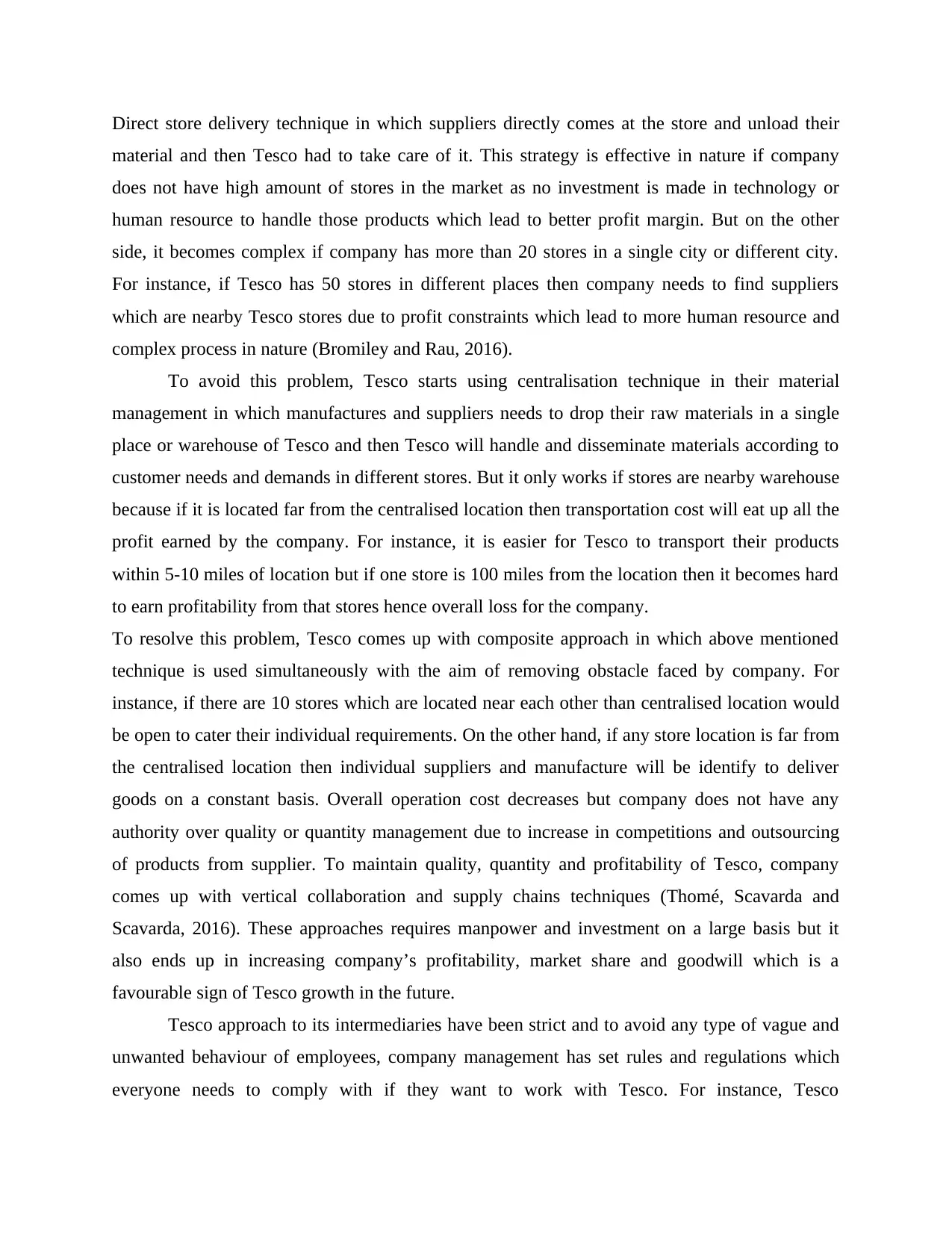
Direct store delivery technique in which suppliers directly comes at the store and unload their
material and then Tesco had to take care of it. This strategy is effective in nature if company
does not have high amount of stores in the market as no investment is made in technology or
human resource to handle those products which lead to better profit margin. But on the other
side, it becomes complex if company has more than 20 stores in a single city or different city.
For instance, if Tesco has 50 stores in different places then company needs to find suppliers
which are nearby Tesco stores due to profit constraints which lead to more human resource and
complex process in nature (Bromiley and Rau, 2016).
To avoid this problem, Tesco starts using centralisation technique in their material
management in which manufactures and suppliers needs to drop their raw materials in a single
place or warehouse of Tesco and then Tesco will handle and disseminate materials according to
customer needs and demands in different stores. But it only works if stores are nearby warehouse
because if it is located far from the centralised location then transportation cost will eat up all the
profit earned by the company. For instance, it is easier for Tesco to transport their products
within 5-10 miles of location but if one store is 100 miles from the location then it becomes hard
to earn profitability from that stores hence overall loss for the company.
To resolve this problem, Tesco comes up with composite approach in which above mentioned
technique is used simultaneously with the aim of removing obstacle faced by company. For
instance, if there are 10 stores which are located near each other than centralised location would
be open to cater their individual requirements. On the other hand, if any store location is far from
the centralised location then individual suppliers and manufacture will be identify to deliver
goods on a constant basis. Overall operation cost decreases but company does not have any
authority over quality or quantity management due to increase in competitions and outsourcing
of products from supplier. To maintain quality, quantity and profitability of Tesco, company
comes up with vertical collaboration and supply chains techniques (Thomé, Scavarda and
Scavarda, 2016). These approaches requires manpower and investment on a large basis but it
also ends up in increasing company’s profitability, market share and goodwill which is a
favourable sign of Tesco growth in the future.
Tesco approach to its intermediaries have been strict and to avoid any type of vague and
unwanted behaviour of employees, company management has set rules and regulations which
everyone needs to comply with if they want to work with Tesco. For instance, Tesco
material and then Tesco had to take care of it. This strategy is effective in nature if company
does not have high amount of stores in the market as no investment is made in technology or
human resource to handle those products which lead to better profit margin. But on the other
side, it becomes complex if company has more than 20 stores in a single city or different city.
For instance, if Tesco has 50 stores in different places then company needs to find suppliers
which are nearby Tesco stores due to profit constraints which lead to more human resource and
complex process in nature (Bromiley and Rau, 2016).
To avoid this problem, Tesco starts using centralisation technique in their material
management in which manufactures and suppliers needs to drop their raw materials in a single
place or warehouse of Tesco and then Tesco will handle and disseminate materials according to
customer needs and demands in different stores. But it only works if stores are nearby warehouse
because if it is located far from the centralised location then transportation cost will eat up all the
profit earned by the company. For instance, it is easier for Tesco to transport their products
within 5-10 miles of location but if one store is 100 miles from the location then it becomes hard
to earn profitability from that stores hence overall loss for the company.
To resolve this problem, Tesco comes up with composite approach in which above mentioned
technique is used simultaneously with the aim of removing obstacle faced by company. For
instance, if there are 10 stores which are located near each other than centralised location would
be open to cater their individual requirements. On the other hand, if any store location is far from
the centralised location then individual suppliers and manufacture will be identify to deliver
goods on a constant basis. Overall operation cost decreases but company does not have any
authority over quality or quantity management due to increase in competitions and outsourcing
of products from supplier. To maintain quality, quantity and profitability of Tesco, company
comes up with vertical collaboration and supply chains techniques (Thomé, Scavarda and
Scavarda, 2016). These approaches requires manpower and investment on a large basis but it
also ends up in increasing company’s profitability, market share and goodwill which is a
favourable sign of Tesco growth in the future.
Tesco approach to its intermediaries have been strict and to avoid any type of vague and
unwanted behaviour of employees, company management has set rules and regulations which
everyone needs to comply with if they want to work with Tesco. For instance, Tesco
Paraphrase This Document
Need a fresh take? Get an instant paraphrase of this document with our AI Paraphraser
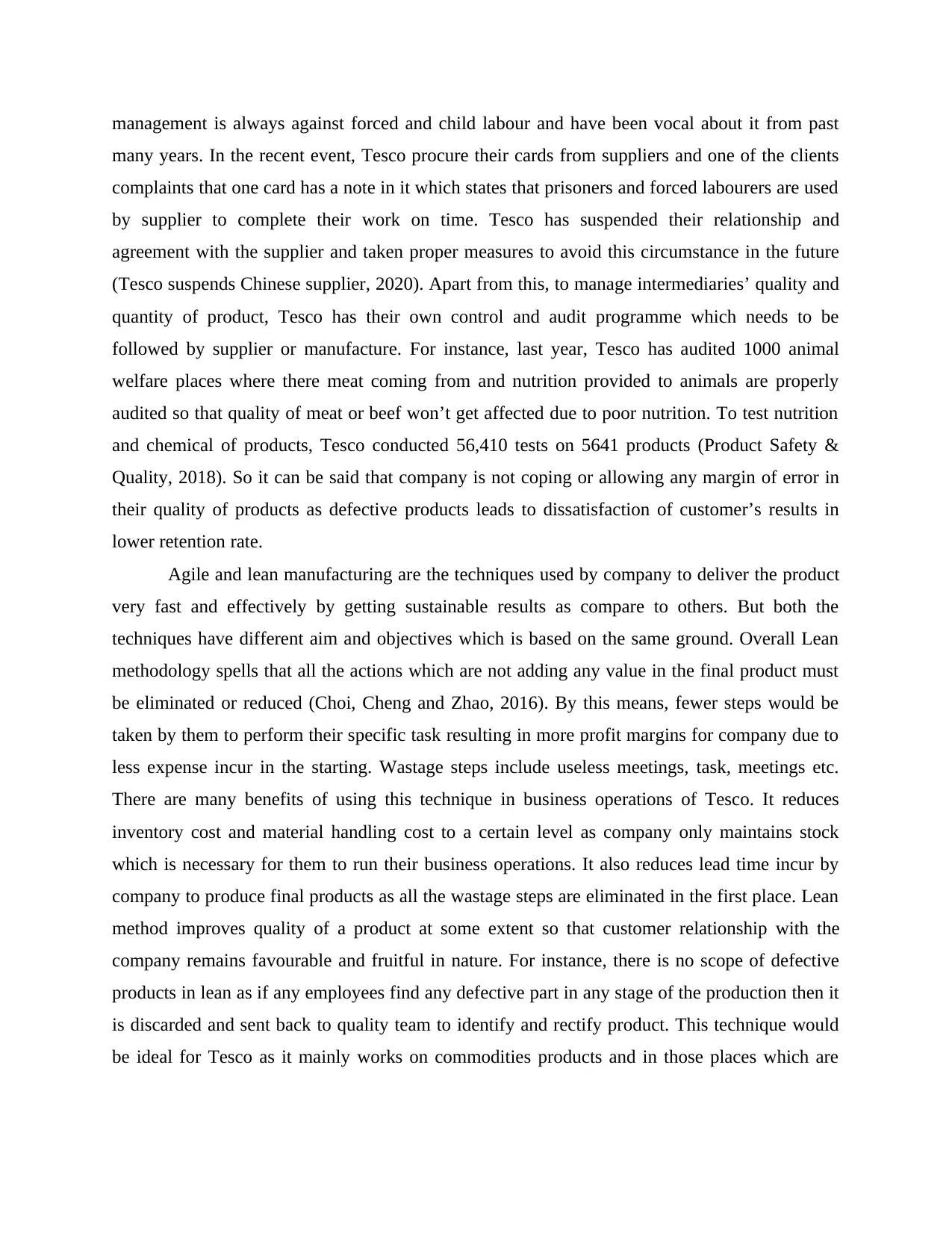
management is always against forced and child labour and have been vocal about it from past
many years. In the recent event, Tesco procure their cards from suppliers and one of the clients
complaints that one card has a note in it which states that prisoners and forced labourers are used
by supplier to complete their work on time. Tesco has suspended their relationship and
agreement with the supplier and taken proper measures to avoid this circumstance in the future
(Tesco suspends Chinese supplier, 2020). Apart from this, to manage intermediaries’ quality and
quantity of product, Tesco has their own control and audit programme which needs to be
followed by supplier or manufacture. For instance, last year, Tesco has audited 1000 animal
welfare places where there meat coming from and nutrition provided to animals are properly
audited so that quality of meat or beef won’t get affected due to poor nutrition. To test nutrition
and chemical of products, Tesco conducted 56,410 tests on 5641 products (Product Safety &
Quality, 2018). So it can be said that company is not coping or allowing any margin of error in
their quality of products as defective products leads to dissatisfaction of customer’s results in
lower retention rate.
Agile and lean manufacturing are the techniques used by company to deliver the product
very fast and effectively by getting sustainable results as compare to others. But both the
techniques have different aim and objectives which is based on the same ground. Overall Lean
methodology spells that all the actions which are not adding any value in the final product must
be eliminated or reduced (Choi, Cheng and Zhao, 2016). By this means, fewer steps would be
taken by them to perform their specific task resulting in more profit margins for company due to
less expense incur in the starting. Wastage steps include useless meetings, task, meetings etc.
There are many benefits of using this technique in business operations of Tesco. It reduces
inventory cost and material handling cost to a certain level as company only maintains stock
which is necessary for them to run their business operations. It also reduces lead time incur by
company to produce final products as all the wastage steps are eliminated in the first place. Lean
method improves quality of a product at some extent so that customer relationship with the
company remains favourable and fruitful in nature. For instance, there is no scope of defective
products in lean as if any employees find any defective part in any stage of the production then it
is discarded and sent back to quality team to identify and rectify product. This technique would
be ideal for Tesco as it mainly works on commodities products and in those places which are
many years. In the recent event, Tesco procure their cards from suppliers and one of the clients
complaints that one card has a note in it which states that prisoners and forced labourers are used
by supplier to complete their work on time. Tesco has suspended their relationship and
agreement with the supplier and taken proper measures to avoid this circumstance in the future
(Tesco suspends Chinese supplier, 2020). Apart from this, to manage intermediaries’ quality and
quantity of product, Tesco has their own control and audit programme which needs to be
followed by supplier or manufacture. For instance, last year, Tesco has audited 1000 animal
welfare places where there meat coming from and nutrition provided to animals are properly
audited so that quality of meat or beef won’t get affected due to poor nutrition. To test nutrition
and chemical of products, Tesco conducted 56,410 tests on 5641 products (Product Safety &
Quality, 2018). So it can be said that company is not coping or allowing any margin of error in
their quality of products as defective products leads to dissatisfaction of customer’s results in
lower retention rate.
Agile and lean manufacturing are the techniques used by company to deliver the product
very fast and effectively by getting sustainable results as compare to others. But both the
techniques have different aim and objectives which is based on the same ground. Overall Lean
methodology spells that all the actions which are not adding any value in the final product must
be eliminated or reduced (Choi, Cheng and Zhao, 2016). By this means, fewer steps would be
taken by them to perform their specific task resulting in more profit margins for company due to
less expense incur in the starting. Wastage steps include useless meetings, task, meetings etc.
There are many benefits of using this technique in business operations of Tesco. It reduces
inventory cost and material handling cost to a certain level as company only maintains stock
which is necessary for them to run their business operations. It also reduces lead time incur by
company to produce final products as all the wastage steps are eliminated in the first place. Lean
method improves quality of a product at some extent so that customer relationship with the
company remains favourable and fruitful in nature. For instance, there is no scope of defective
products in lean as if any employees find any defective part in any stage of the production then it
is discarded and sent back to quality team to identify and rectify product. This technique would
be ideal for Tesco as it mainly works on commodities products and in those places which are
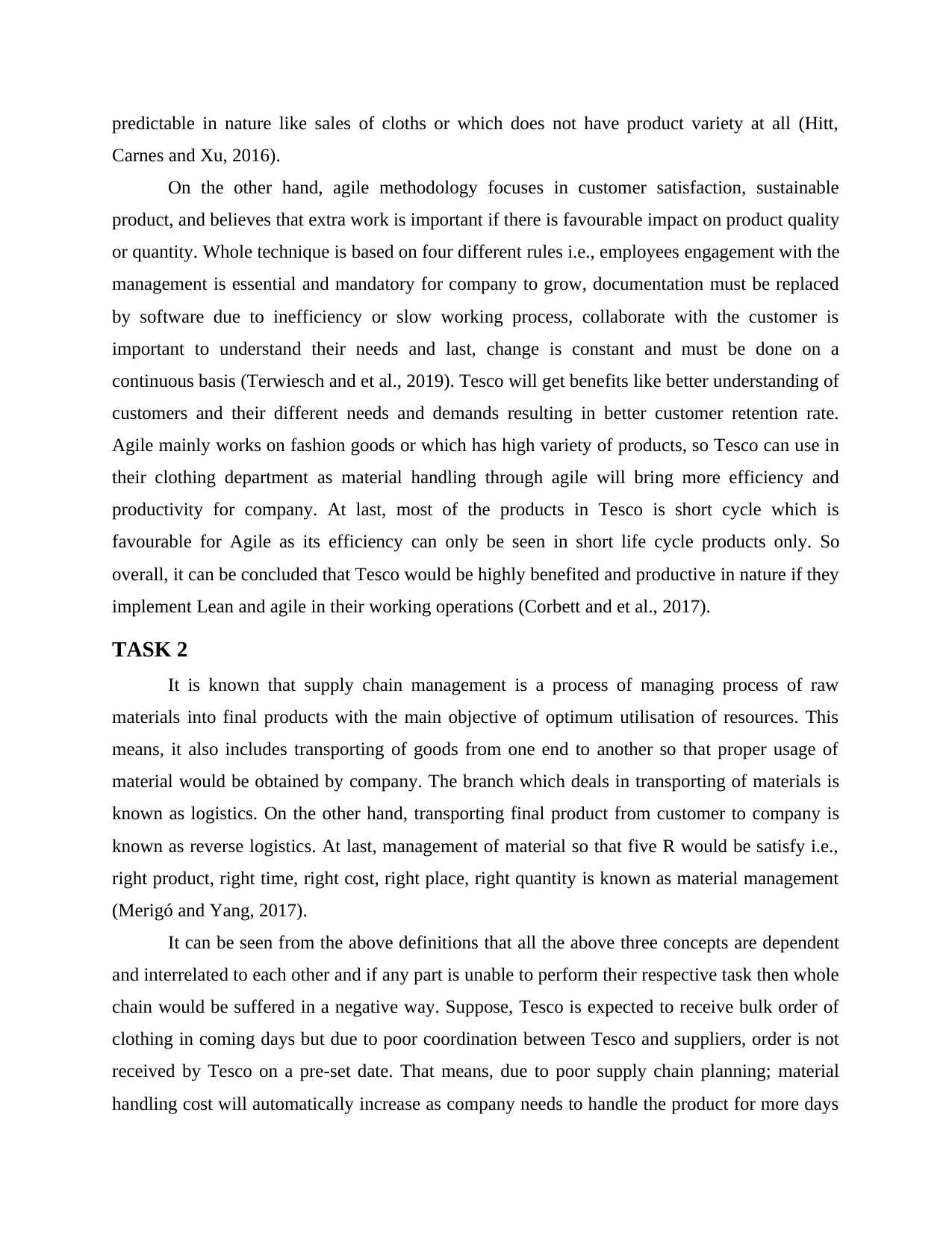
predictable in nature like sales of cloths or which does not have product variety at all (Hitt,
Carnes and Xu, 2016).
On the other hand, agile methodology focuses in customer satisfaction, sustainable
product, and believes that extra work is important if there is favourable impact on product quality
or quantity. Whole technique is based on four different rules i.e., employees engagement with the
management is essential and mandatory for company to grow, documentation must be replaced
by software due to inefficiency or slow working process, collaborate with the customer is
important to understand their needs and last, change is constant and must be done on a
continuous basis (Terwiesch and et al., 2019). Tesco will get benefits like better understanding of
customers and their different needs and demands resulting in better customer retention rate.
Agile mainly works on fashion goods or which has high variety of products, so Tesco can use in
their clothing department as material handling through agile will bring more efficiency and
productivity for company. At last, most of the products in Tesco is short cycle which is
favourable for Agile as its efficiency can only be seen in short life cycle products only. So
overall, it can be concluded that Tesco would be highly benefited and productive in nature if they
implement Lean and agile in their working operations (Corbett and et al., 2017).
TASK 2
It is known that supply chain management is a process of managing process of raw
materials into final products with the main objective of optimum utilisation of resources. This
means, it also includes transporting of goods from one end to another so that proper usage of
material would be obtained by company. The branch which deals in transporting of materials is
known as logistics. On the other hand, transporting final product from customer to company is
known as reverse logistics. At last, management of material so that five R would be satisfy i.e.,
right product, right time, right cost, right place, right quantity is known as material management
(Merigó and Yang, 2017).
It can be seen from the above definitions that all the above three concepts are dependent
and interrelated to each other and if any part is unable to perform their respective task then whole
chain would be suffered in a negative way. Suppose, Tesco is expected to receive bulk order of
clothing in coming days but due to poor coordination between Tesco and suppliers, order is not
received by Tesco on a pre-set date. That means, due to poor supply chain planning; material
handling cost will automatically increase as company needs to handle the product for more days
Carnes and Xu, 2016).
On the other hand, agile methodology focuses in customer satisfaction, sustainable
product, and believes that extra work is important if there is favourable impact on product quality
or quantity. Whole technique is based on four different rules i.e., employees engagement with the
management is essential and mandatory for company to grow, documentation must be replaced
by software due to inefficiency or slow working process, collaborate with the customer is
important to understand their needs and last, change is constant and must be done on a
continuous basis (Terwiesch and et al., 2019). Tesco will get benefits like better understanding of
customers and their different needs and demands resulting in better customer retention rate.
Agile mainly works on fashion goods or which has high variety of products, so Tesco can use in
their clothing department as material handling through agile will bring more efficiency and
productivity for company. At last, most of the products in Tesco is short cycle which is
favourable for Agile as its efficiency can only be seen in short life cycle products only. So
overall, it can be concluded that Tesco would be highly benefited and productive in nature if they
implement Lean and agile in their working operations (Corbett and et al., 2017).
TASK 2
It is known that supply chain management is a process of managing process of raw
materials into final products with the main objective of optimum utilisation of resources. This
means, it also includes transporting of goods from one end to another so that proper usage of
material would be obtained by company. The branch which deals in transporting of materials is
known as logistics. On the other hand, transporting final product from customer to company is
known as reverse logistics. At last, management of material so that five R would be satisfy i.e.,
right product, right time, right cost, right place, right quantity is known as material management
(Merigó and Yang, 2017).
It can be seen from the above definitions that all the above three concepts are dependent
and interrelated to each other and if any part is unable to perform their respective task then whole
chain would be suffered in a negative way. Suppose, Tesco is expected to receive bulk order of
clothing in coming days but due to poor coordination between Tesco and suppliers, order is not
received by Tesco on a pre-set date. That means, due to poor supply chain planning; material
handling cost will automatically increase as company needs to handle the product for more days
⊘ This is a preview!⊘
Do you want full access?
Subscribe today to unlock all pages.

Trusted by 1+ million students worldwide
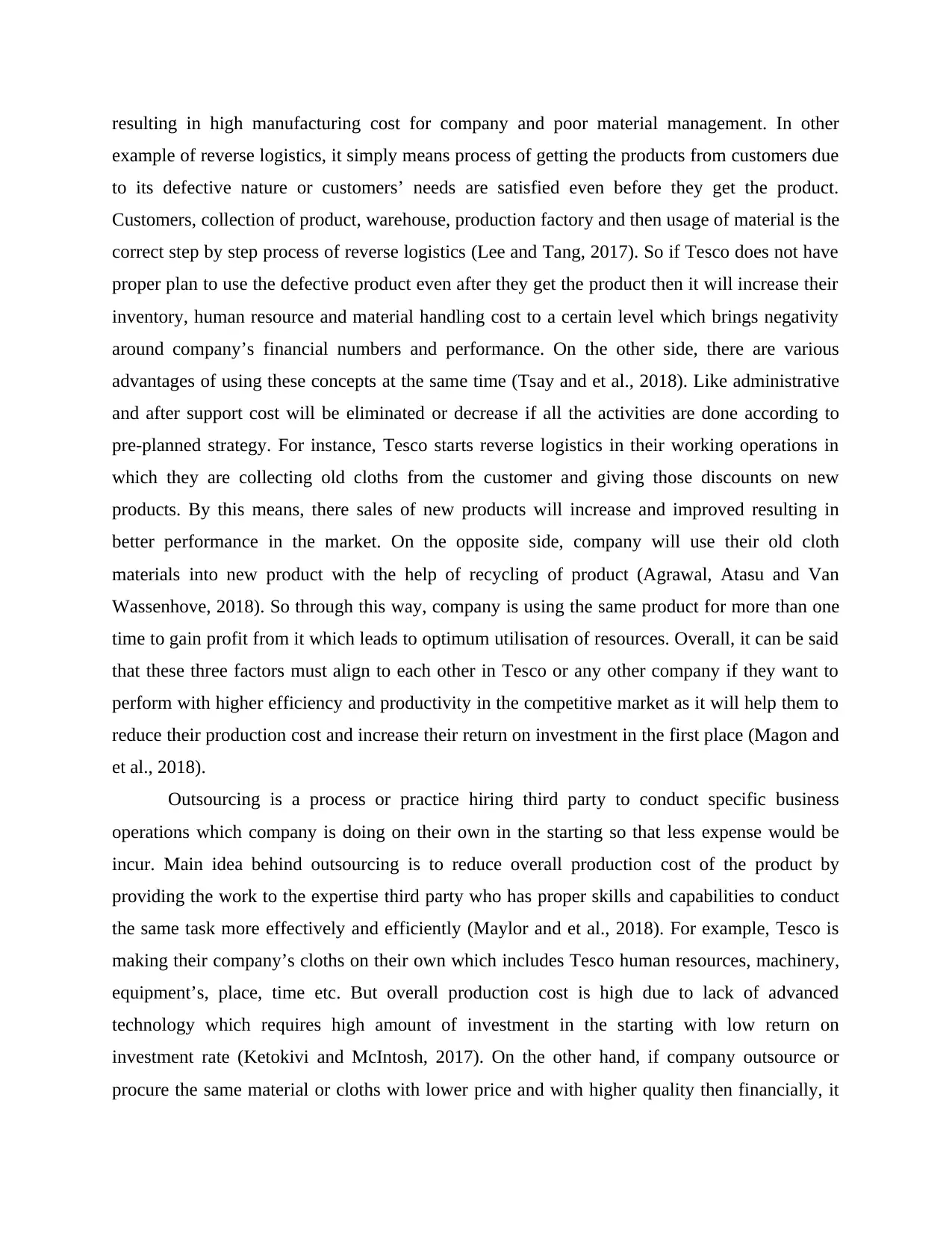
resulting in high manufacturing cost for company and poor material management. In other
example of reverse logistics, it simply means process of getting the products from customers due
to its defective nature or customers’ needs are satisfied even before they get the product.
Customers, collection of product, warehouse, production factory and then usage of material is the
correct step by step process of reverse logistics (Lee and Tang, 2017). So if Tesco does not have
proper plan to use the defective product even after they get the product then it will increase their
inventory, human resource and material handling cost to a certain level which brings negativity
around company’s financial numbers and performance. On the other side, there are various
advantages of using these concepts at the same time (Tsay and et al., 2018). Like administrative
and after support cost will be eliminated or decrease if all the activities are done according to
pre-planned strategy. For instance, Tesco starts reverse logistics in their working operations in
which they are collecting old cloths from the customer and giving those discounts on new
products. By this means, there sales of new products will increase and improved resulting in
better performance in the market. On the opposite side, company will use their old cloth
materials into new product with the help of recycling of product (Agrawal, Atasu and Van
Wassenhove, 2018). So through this way, company is using the same product for more than one
time to gain profit from it which leads to optimum utilisation of resources. Overall, it can be said
that these three factors must align to each other in Tesco or any other company if they want to
perform with higher efficiency and productivity in the competitive market as it will help them to
reduce their production cost and increase their return on investment in the first place (Magon and
et al., 2018).
Outsourcing is a process or practice hiring third party to conduct specific business
operations which company is doing on their own in the starting so that less expense would be
incur. Main idea behind outsourcing is to reduce overall production cost of the product by
providing the work to the expertise third party who has proper skills and capabilities to conduct
the same task more effectively and efficiently (Maylor and et al., 2018). For example, Tesco is
making their company’s cloths on their own which includes Tesco human resources, machinery,
equipment’s, place, time etc. But overall production cost is high due to lack of advanced
technology which requires high amount of investment in the starting with low return on
investment rate (Ketokivi and McIntosh, 2017). On the other hand, if company outsource or
procure the same material or cloths with lower price and with higher quality then financially, it
example of reverse logistics, it simply means process of getting the products from customers due
to its defective nature or customers’ needs are satisfied even before they get the product.
Customers, collection of product, warehouse, production factory and then usage of material is the
correct step by step process of reverse logistics (Lee and Tang, 2017). So if Tesco does not have
proper plan to use the defective product even after they get the product then it will increase their
inventory, human resource and material handling cost to a certain level which brings negativity
around company’s financial numbers and performance. On the other side, there are various
advantages of using these concepts at the same time (Tsay and et al., 2018). Like administrative
and after support cost will be eliminated or decrease if all the activities are done according to
pre-planned strategy. For instance, Tesco starts reverse logistics in their working operations in
which they are collecting old cloths from the customer and giving those discounts on new
products. By this means, there sales of new products will increase and improved resulting in
better performance in the market. On the opposite side, company will use their old cloth
materials into new product with the help of recycling of product (Agrawal, Atasu and Van
Wassenhove, 2018). So through this way, company is using the same product for more than one
time to gain profit from it which leads to optimum utilisation of resources. Overall, it can be said
that these three factors must align to each other in Tesco or any other company if they want to
perform with higher efficiency and productivity in the competitive market as it will help them to
reduce their production cost and increase their return on investment in the first place (Magon and
et al., 2018).
Outsourcing is a process or practice hiring third party to conduct specific business
operations which company is doing on their own in the starting so that less expense would be
incur. Main idea behind outsourcing is to reduce overall production cost of the product by
providing the work to the expertise third party who has proper skills and capabilities to conduct
the same task more effectively and efficiently (Maylor and et al., 2018). For example, Tesco is
making their company’s cloths on their own which includes Tesco human resources, machinery,
equipment’s, place, time etc. But overall production cost is high due to lack of advanced
technology which requires high amount of investment in the starting with low return on
investment rate (Ketokivi and McIntosh, 2017). On the other hand, if company outsource or
procure the same material or cloths with lower price and with higher quality then financially, it
Paraphrase This Document
Need a fresh take? Get an instant paraphrase of this document with our AI Paraphraser
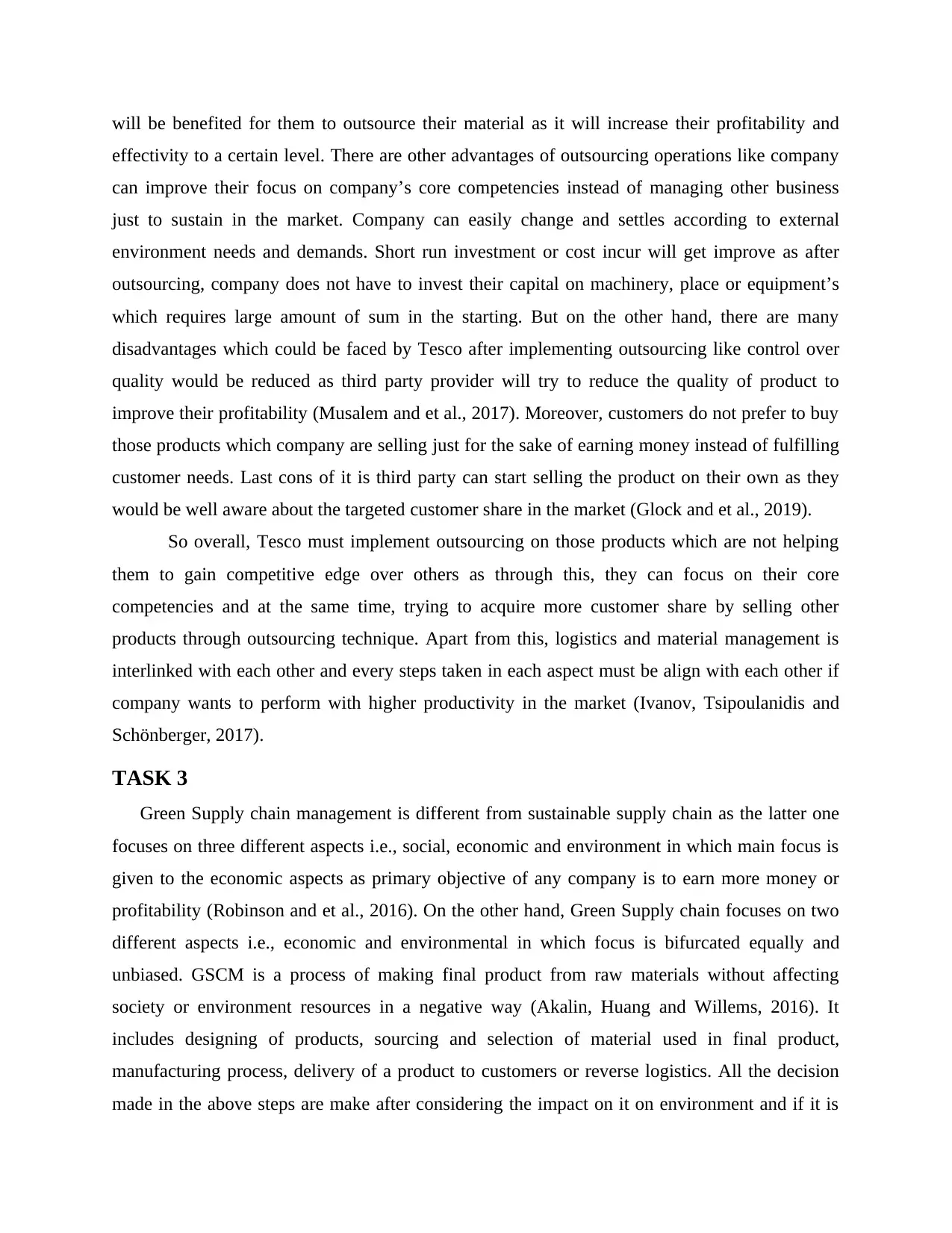
will be benefited for them to outsource their material as it will increase their profitability and
effectivity to a certain level. There are other advantages of outsourcing operations like company
can improve their focus on company’s core competencies instead of managing other business
just to sustain in the market. Company can easily change and settles according to external
environment needs and demands. Short run investment or cost incur will get improve as after
outsourcing, company does not have to invest their capital on machinery, place or equipment’s
which requires large amount of sum in the starting. But on the other hand, there are many
disadvantages which could be faced by Tesco after implementing outsourcing like control over
quality would be reduced as third party provider will try to reduce the quality of product to
improve their profitability (Musalem and et al., 2017). Moreover, customers do not prefer to buy
those products which company are selling just for the sake of earning money instead of fulfilling
customer needs. Last cons of it is third party can start selling the product on their own as they
would be well aware about the targeted customer share in the market (Glock and et al., 2019).
So overall, Tesco must implement outsourcing on those products which are not helping
them to gain competitive edge over others as through this, they can focus on their core
competencies and at the same time, trying to acquire more customer share by selling other
products through outsourcing technique. Apart from this, logistics and material management is
interlinked with each other and every steps taken in each aspect must be align with each other if
company wants to perform with higher productivity in the market (Ivanov, Tsipoulanidis and
Schönberger, 2017).
TASK 3
Green Supply chain management is different from sustainable supply chain as the latter one
focuses on three different aspects i.e., social, economic and environment in which main focus is
given to the economic aspects as primary objective of any company is to earn more money or
profitability (Robinson and et al., 2016). On the other hand, Green Supply chain focuses on two
different aspects i.e., economic and environmental in which focus is bifurcated equally and
unbiased. GSCM is a process of making final product from raw materials without affecting
society or environment resources in a negative way (Akalin, Huang and Willems, 2016). It
includes designing of products, sourcing and selection of material used in final product,
manufacturing process, delivery of a product to customers or reverse logistics. All the decision
made in the above steps are make after considering the impact on it on environment and if it is
effectivity to a certain level. There are other advantages of outsourcing operations like company
can improve their focus on company’s core competencies instead of managing other business
just to sustain in the market. Company can easily change and settles according to external
environment needs and demands. Short run investment or cost incur will get improve as after
outsourcing, company does not have to invest their capital on machinery, place or equipment’s
which requires large amount of sum in the starting. But on the other hand, there are many
disadvantages which could be faced by Tesco after implementing outsourcing like control over
quality would be reduced as third party provider will try to reduce the quality of product to
improve their profitability (Musalem and et al., 2017). Moreover, customers do not prefer to buy
those products which company are selling just for the sake of earning money instead of fulfilling
customer needs. Last cons of it is third party can start selling the product on their own as they
would be well aware about the targeted customer share in the market (Glock and et al., 2019).
So overall, Tesco must implement outsourcing on those products which are not helping
them to gain competitive edge over others as through this, they can focus on their core
competencies and at the same time, trying to acquire more customer share by selling other
products through outsourcing technique. Apart from this, logistics and material management is
interlinked with each other and every steps taken in each aspect must be align with each other if
company wants to perform with higher productivity in the market (Ivanov, Tsipoulanidis and
Schönberger, 2017).
TASK 3
Green Supply chain management is different from sustainable supply chain as the latter one
focuses on three different aspects i.e., social, economic and environment in which main focus is
given to the economic aspects as primary objective of any company is to earn more money or
profitability (Robinson and et al., 2016). On the other hand, Green Supply chain focuses on two
different aspects i.e., economic and environmental in which focus is bifurcated equally and
unbiased. GSCM is a process of making final product from raw materials without affecting
society or environment resources in a negative way (Akalin, Huang and Willems, 2016). It
includes designing of products, sourcing and selection of material used in final product,
manufacturing process, delivery of a product to customers or reverse logistics. All the decision
made in the above steps are make after considering the impact on it on environment and if it is
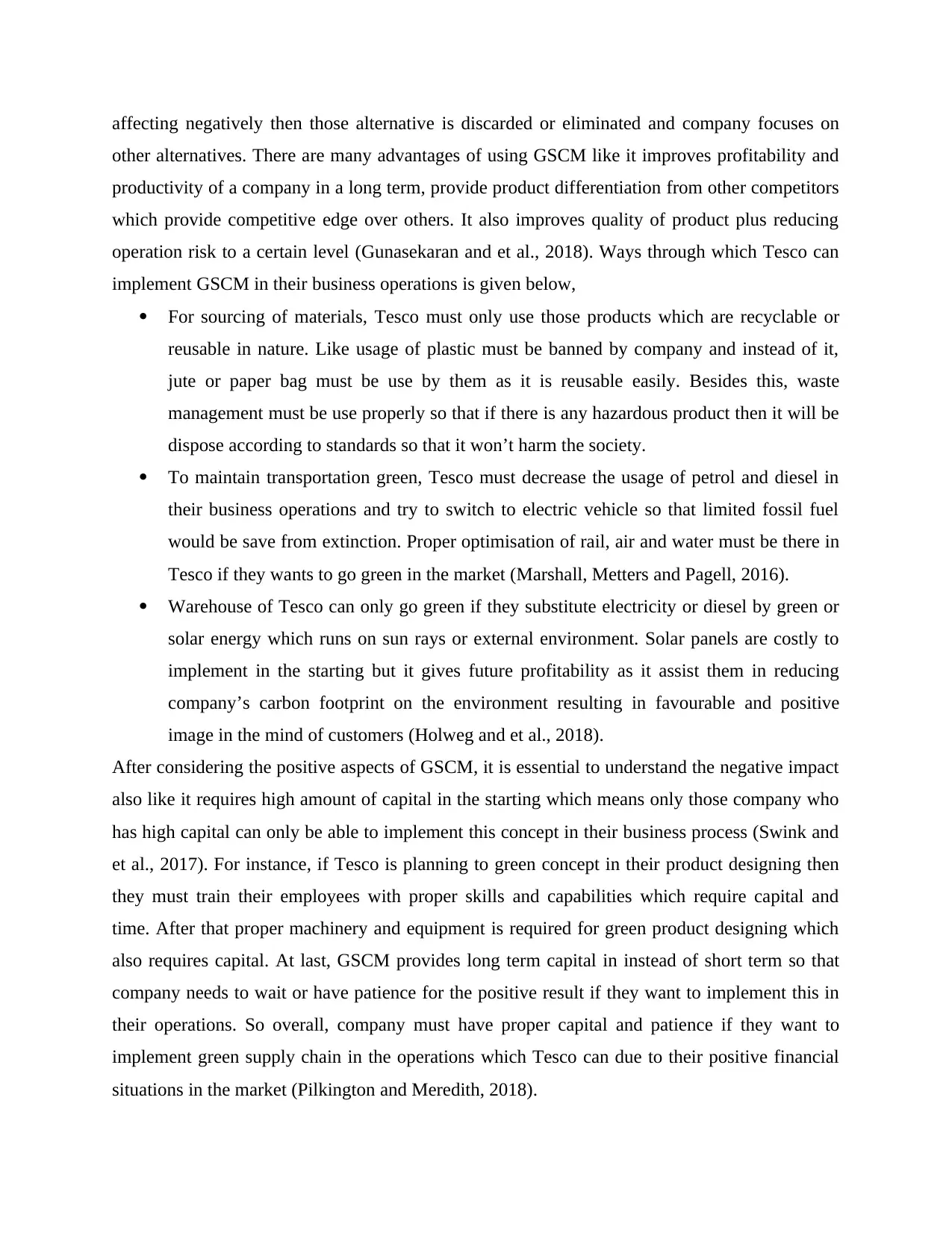
affecting negatively then those alternative is discarded or eliminated and company focuses on
other alternatives. There are many advantages of using GSCM like it improves profitability and
productivity of a company in a long term, provide product differentiation from other competitors
which provide competitive edge over others. It also improves quality of product plus reducing
operation risk to a certain level (Gunasekaran and et al., 2018). Ways through which Tesco can
implement GSCM in their business operations is given below,
For sourcing of materials, Tesco must only use those products which are recyclable or
reusable in nature. Like usage of plastic must be banned by company and instead of it,
jute or paper bag must be use by them as it is reusable easily. Besides this, waste
management must be use properly so that if there is any hazardous product then it will be
dispose according to standards so that it won’t harm the society.
To maintain transportation green, Tesco must decrease the usage of petrol and diesel in
their business operations and try to switch to electric vehicle so that limited fossil fuel
would be save from extinction. Proper optimisation of rail, air and water must be there in
Tesco if they wants to go green in the market (Marshall, Metters and Pagell, 2016).
Warehouse of Tesco can only go green if they substitute electricity or diesel by green or
solar energy which runs on sun rays or external environment. Solar panels are costly to
implement in the starting but it gives future profitability as it assist them in reducing
company’s carbon footprint on the environment resulting in favourable and positive
image in the mind of customers (Holweg and et al., 2018).
After considering the positive aspects of GSCM, it is essential to understand the negative impact
also like it requires high amount of capital in the starting which means only those company who
has high capital can only be able to implement this concept in their business process (Swink and
et al., 2017). For instance, if Tesco is planning to green concept in their product designing then
they must train their employees with proper skills and capabilities which require capital and
time. After that proper machinery and equipment is required for green product designing which
also requires capital. At last, GSCM provides long term capital in instead of short term so that
company needs to wait or have patience for the positive result if they want to implement this in
their operations. So overall, company must have proper capital and patience if they want to
implement green supply chain in the operations which Tesco can due to their positive financial
situations in the market (Pilkington and Meredith, 2018).
other alternatives. There are many advantages of using GSCM like it improves profitability and
productivity of a company in a long term, provide product differentiation from other competitors
which provide competitive edge over others. It also improves quality of product plus reducing
operation risk to a certain level (Gunasekaran and et al., 2018). Ways through which Tesco can
implement GSCM in their business operations is given below,
For sourcing of materials, Tesco must only use those products which are recyclable or
reusable in nature. Like usage of plastic must be banned by company and instead of it,
jute or paper bag must be use by them as it is reusable easily. Besides this, waste
management must be use properly so that if there is any hazardous product then it will be
dispose according to standards so that it won’t harm the society.
To maintain transportation green, Tesco must decrease the usage of petrol and diesel in
their business operations and try to switch to electric vehicle so that limited fossil fuel
would be save from extinction. Proper optimisation of rail, air and water must be there in
Tesco if they wants to go green in the market (Marshall, Metters and Pagell, 2016).
Warehouse of Tesco can only go green if they substitute electricity or diesel by green or
solar energy which runs on sun rays or external environment. Solar panels are costly to
implement in the starting but it gives future profitability as it assist them in reducing
company’s carbon footprint on the environment resulting in favourable and positive
image in the mind of customers (Holweg and et al., 2018).
After considering the positive aspects of GSCM, it is essential to understand the negative impact
also like it requires high amount of capital in the starting which means only those company who
has high capital can only be able to implement this concept in their business process (Swink and
et al., 2017). For instance, if Tesco is planning to green concept in their product designing then
they must train their employees with proper skills and capabilities which require capital and
time. After that proper machinery and equipment is required for green product designing which
also requires capital. At last, GSCM provides long term capital in instead of short term so that
company needs to wait or have patience for the positive result if they want to implement this in
their operations. So overall, company must have proper capital and patience if they want to
implement green supply chain in the operations which Tesco can due to their positive financial
situations in the market (Pilkington and Meredith, 2018).
⊘ This is a preview!⊘
Do you want full access?
Subscribe today to unlock all pages.

Trusted by 1+ million students worldwide

Information Technology is an essential aspect of GSCM as without it, it is not possible
for any company to successfully implement the same. For instance, documentation work or
usage of paper in Tesco can only be removed if employees are train enough to use computers or
laptops for documentation or calculation (He, Mak and Rong, 2019). So technology helps them
to reduce their usage of paper which comes from Trees and shortage of tree is one of the reasons
behind global warming. Apart from this, Tesco is already using scanner to track their order and
reduce frequency of usage of transportation so that less diesel would be used by them. In
Material planning, company needs to procure those materials which are easily reusable in nature
and have no or less negative impact on society and at the same time fulfilling customers’ needs
and demands. For instance, company provides training to their suppliers and manufacturer for
sustainable and green farming according to standards so that vertical integration process of Tesco
becomes sustainable (Meredith and Pilkington, 2018). Besides this, under material planning,
Tesco has planned to remove one billion plastic packets by 2020 so that they can play their part
in making environment green and sustainable (Remove, Reduce, Reuse, Recycle, 2020).
Figure 1: Green Reverse Logistics
Whole reverse logistics can go green if company wants to and have proper resources to
accomplish this task. Tesco does not have to do anything unique to implement green reverse
logistics as their green technique in production process will assist them to implement the same.
For instance, if paper bags are used by Tesco for packaging their goods in the starting then while
returning their product from customers (Waleczek and et al., 2019). Company needs to ask for
for any company to successfully implement the same. For instance, documentation work or
usage of paper in Tesco can only be removed if employees are train enough to use computers or
laptops for documentation or calculation (He, Mak and Rong, 2019). So technology helps them
to reduce their usage of paper which comes from Trees and shortage of tree is one of the reasons
behind global warming. Apart from this, Tesco is already using scanner to track their order and
reduce frequency of usage of transportation so that less diesel would be used by them. In
Material planning, company needs to procure those materials which are easily reusable in nature
and have no or less negative impact on society and at the same time fulfilling customers’ needs
and demands. For instance, company provides training to their suppliers and manufacturer for
sustainable and green farming according to standards so that vertical integration process of Tesco
becomes sustainable (Meredith and Pilkington, 2018). Besides this, under material planning,
Tesco has planned to remove one billion plastic packets by 2020 so that they can play their part
in making environment green and sustainable (Remove, Reduce, Reuse, Recycle, 2020).
Figure 1: Green Reverse Logistics
Whole reverse logistics can go green if company wants to and have proper resources to
accomplish this task. Tesco does not have to do anything unique to implement green reverse
logistics as their green technique in production process will assist them to implement the same.
For instance, if paper bags are used by Tesco for packaging their goods in the starting then while
returning their product from customers (Waleczek and et al., 2019). Company needs to ask for
Paraphrase This Document
Need a fresh take? Get an instant paraphrase of this document with our AI Paraphraser

the package also so that it would be recycle so that company could reuse in the future. So by
implementing green strategy in starting will help them to perform sustainable performance in the
end also. In other example of product distribution, Tesco must try to reduce their frequency of
usage of vehicle and increase their collection of products from customers by using less fossil fuel
so that less carbon footprint would be made by them while conducting their business operations
(Haniff and Caldwell, 2019).
implementing green strategy in starting will help them to perform sustainable performance in the
end also. In other example of product distribution, Tesco must try to reduce their frequency of
usage of vehicle and increase their collection of products from customers by using less fossil fuel
so that less carbon footprint would be made by them while conducting their business operations
(Haniff and Caldwell, 2019).
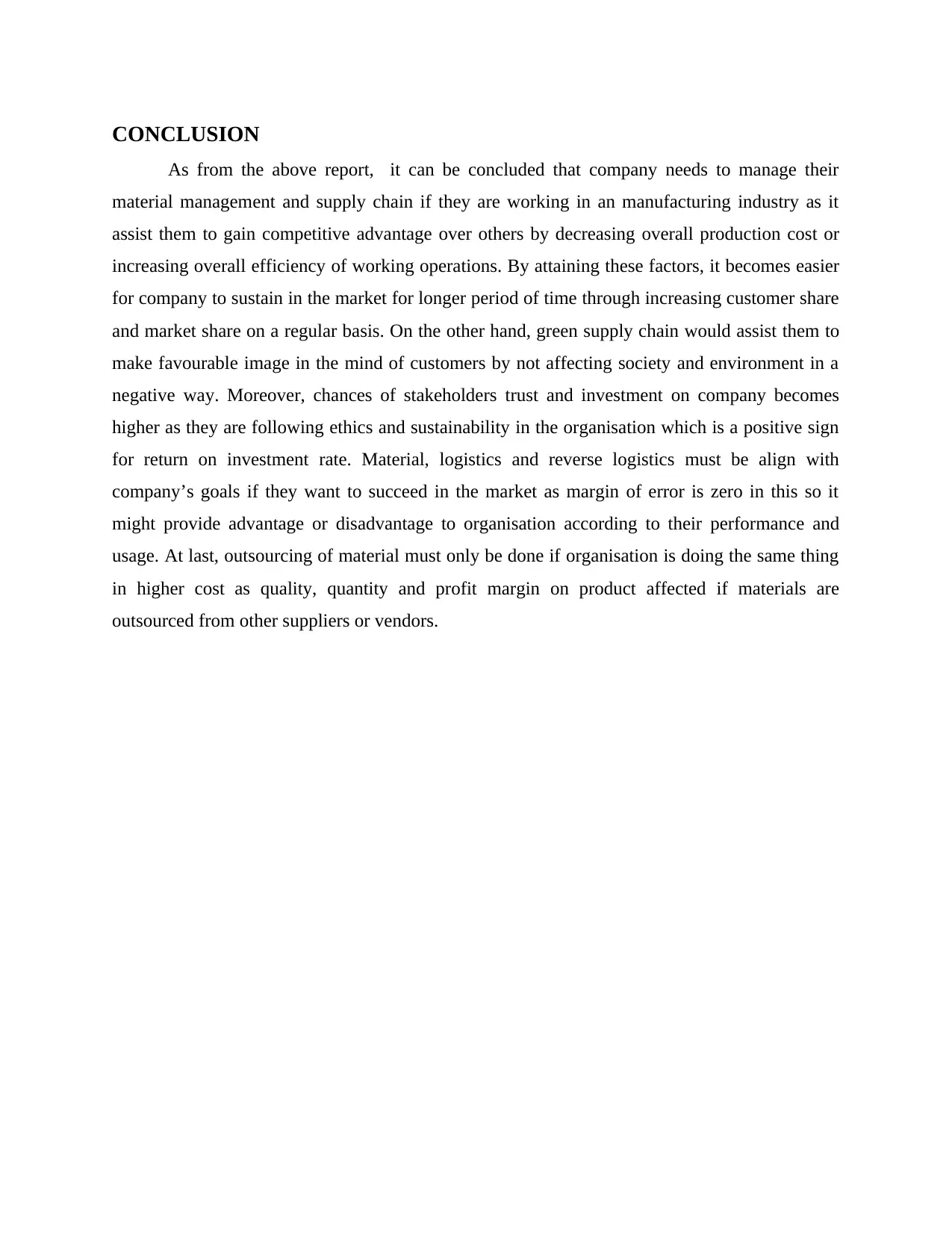
CONCLUSION
As from the above report, it can be concluded that company needs to manage their
material management and supply chain if they are working in an manufacturing industry as it
assist them to gain competitive advantage over others by decreasing overall production cost or
increasing overall efficiency of working operations. By attaining these factors, it becomes easier
for company to sustain in the market for longer period of time through increasing customer share
and market share on a regular basis. On the other hand, green supply chain would assist them to
make favourable image in the mind of customers by not affecting society and environment in a
negative way. Moreover, chances of stakeholders trust and investment on company becomes
higher as they are following ethics and sustainability in the organisation which is a positive sign
for return on investment rate. Material, logistics and reverse logistics must be align with
company’s goals if they want to succeed in the market as margin of error is zero in this so it
might provide advantage or disadvantage to organisation according to their performance and
usage. At last, outsourcing of material must only be done if organisation is doing the same thing
in higher cost as quality, quantity and profit margin on product affected if materials are
outsourced from other suppliers or vendors.
As from the above report, it can be concluded that company needs to manage their
material management and supply chain if they are working in an manufacturing industry as it
assist them to gain competitive advantage over others by decreasing overall production cost or
increasing overall efficiency of working operations. By attaining these factors, it becomes easier
for company to sustain in the market for longer period of time through increasing customer share
and market share on a regular basis. On the other hand, green supply chain would assist them to
make favourable image in the mind of customers by not affecting society and environment in a
negative way. Moreover, chances of stakeholders trust and investment on company becomes
higher as they are following ethics and sustainability in the organisation which is a positive sign
for return on investment rate. Material, logistics and reverse logistics must be align with
company’s goals if they want to succeed in the market as margin of error is zero in this so it
might provide advantage or disadvantage to organisation according to their performance and
usage. At last, outsourcing of material must only be done if organisation is doing the same thing
in higher cost as quality, quantity and profit margin on product affected if materials are
outsourced from other suppliers or vendors.
⊘ This is a preview!⊘
Do you want full access?
Subscribe today to unlock all pages.

Trusted by 1+ million students worldwide
1 out of 16
Related Documents
Your All-in-One AI-Powered Toolkit for Academic Success.
+13062052269
info@desklib.com
Available 24*7 on WhatsApp / Email
![[object Object]](/_next/static/media/star-bottom.7253800d.svg)
Unlock your academic potential
Copyright © 2020–2025 A2Z Services. All Rights Reserved. Developed and managed by ZUCOL.





